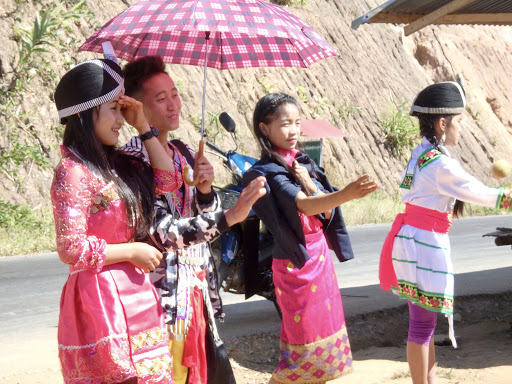
Over the centuries, Boten served as a
passageway for ethnic groups migrating from China into north-eastern Laos. Some
Tai Lue sprang up in and around Boten, while most moved into the mountains and
river valleys in Luang Namtha Province and beyond.
Today, some 20 diverse ethnic groups live
in Luang Namtha. The most common are the Akha and Khmu, who account for about
half of the province’s population. Each has its distinct traditions,
lifestyles, beliefs, and clothing, and you can visit their villages on a day
trip to Luang Namtha Town, a 55-km drive from Boten. The more adventurous can
trek to ethnic villages and experience culture and way of life on an overnight
homestay.
The Akha live in the mountains, and
follow a cultural code called Akha Zang, the “Akha Way”. This defines traditions
and laws, as well as how they farm, hunt, treat illnesses, and relate to each
other and outsiders. Women wear black cotton miniskirts, tight-fitting bodices,
embroidered jackets, and intricate head-dresses. Villages feature tall swings
and gates marking the boundary between the human and natural worlds.
The Khmu migrated to Laos thousands
of years ago. They practice animism and spirit worship, and rely on the forest
for growing rice, hunting and gathering, and producing woven rattan and bamboo
basketry, tools, and net-bags. When visiting a Khmu village, taste their Lao
hai (jar wine).
The Hmong have established hilltop
villages in mountainous Luang Namtha, and are skilled at hunting, mixing herbal
medicines and raising animals. Intricate embroidery and heavy silver jewellery
adorn their clothes, and some villages create batik designs using beeswax and
indigo dyes. The Hmong New Year in December/January is a popular nationwide
celebration. Women wear their finest clothes, courting couples toss mak kone
(small fabric balls), people dance and drink, and villages hold competitions
like top-spinning.
A small number of Lahu (“tiger
breeder”) live in Luang Namtha, having moved into Laos from China. They
practice a distinct form of ancestor and phi (spirit) worship related to
natural phenomena, the forest, houses, and livestock. Rituals and celebrations
revolve around the agricultural cycle, marriage and house-building. The Lahu
New Year occurs in January/February.
The Lanten migrated from China, bringing
cultural practices and beliefs based on Taoism mixed with ancestor and spirit
worship. They mostly live along streams and rivers, and can easily be visited
throughout Luang Namtha. The Lanten wear pink-trimmed indigo-dyed cotton
clothes, and produce cotton cloth, ceremonial masks and bamboo paper, on which
men record religious texts with ancient Chinese characters.
The Tai Daeng, who migrated from
China, specialise in silk weaving, and visitors can see the entire process from
boiling cocoons to working a vertical loom. Aside from weaving, the labour
division tends to be equal between men and women, with both engaged in
ploughing, rice farming, fishing, cooking, caring for babies, and cleaning.
Many Tai Daeng combine animism with Buddhism, and villages usually have a
temple.
Ancestors of Luang Namtha’s Tai Dam
migrated to the Nam Tha valley from north-western Vietnam in the late 19th
century. Unlike Buddhist Tai groups, the Tai Dam worship phi and their
ancestors. Women wear colourful head-scarves and tight-fitting shirts with
silver buttons. They make potent lao lao rice alcohol, and produce fine
silk and cotton textiles.
The Tai Lue began migrating to Luang
Namtha’s Sing District from southern China in the 15th century. They are known
for their stilt houses with long sloping roofs, strong lao lao liquor,
and intricate silk and cotton textiles. Tai Lue practice a mix of animism and
Buddhism, and most villages have a temple and monks, as well as a sacred pillar
where they hold rituals for natural spirits.
The Yao, also known as the Mien, are highland people, who originated in China. Their houses are made of durable hardwood, and known to be large and sturdy. They grow rice and corn, and gather wild jungle products such as resin and honey. Young men study Chinese characters to express Yao concepts. Yao men wear earrings and embroidered tunics, while women dress in elaborate costumes with bright red collars. The Yao are influenced by their ancestors, as well as their animistic and Tao beliefs.
